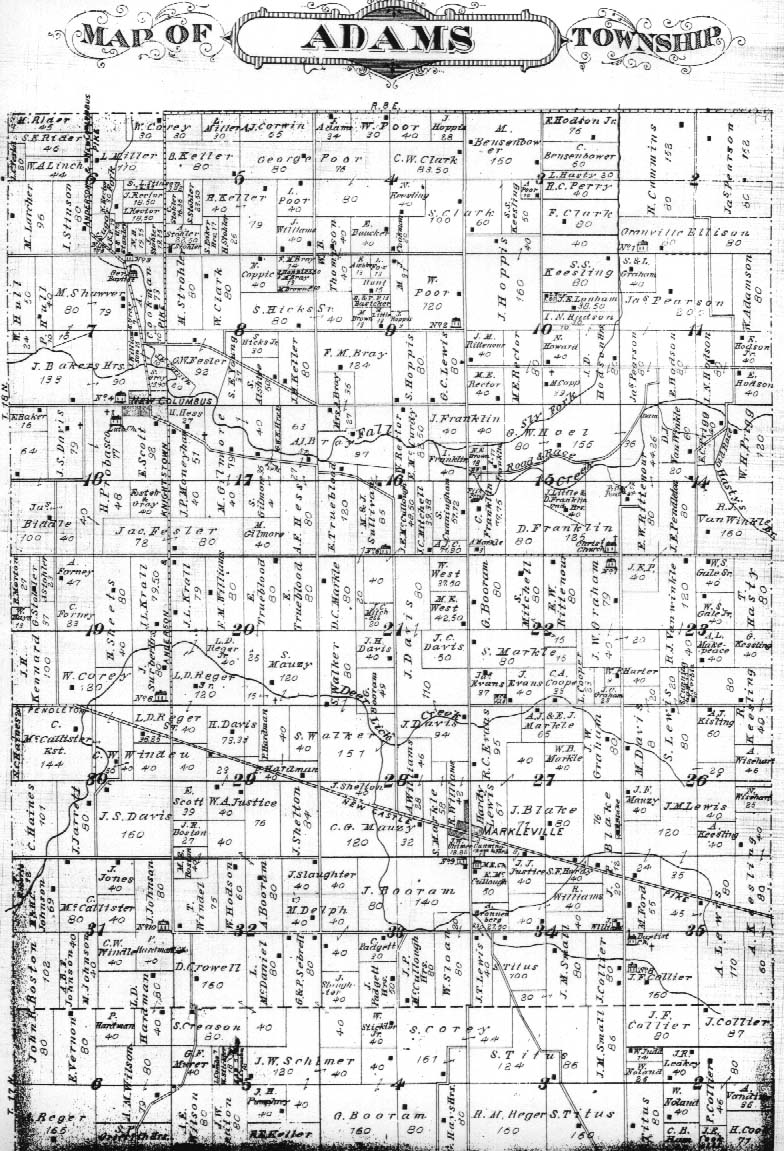|
Pioneer
Cemeteries and Their Stories, Madison County, Indiana |
 |
|
Pioneer
Cemeteries and Their Stories, Madison County, Indiana |
 |
Adams Township--Abraham Adams 1823
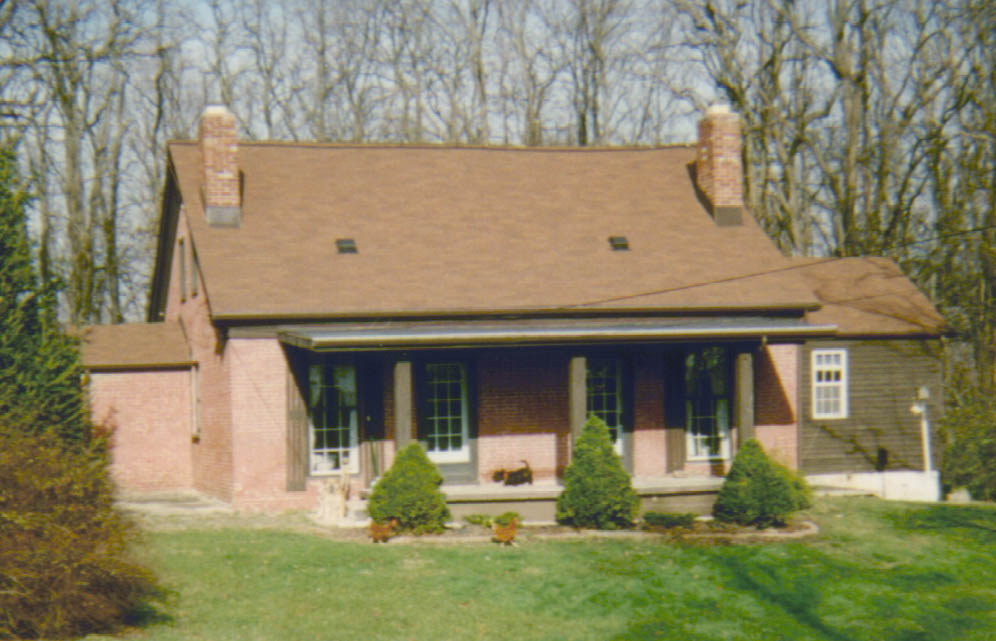 |
|
The Morris Gilmore house, built in 1838, was the first brick house in the township. Like the other brick structures of that era in the county, the bricks were made on location. The clay for the bricks was taken from the knoll across the road. The timber used in the house was taken from the surrounding forest. The Gilmore family's first shelter, a log cabin, originally stood in what is now this house's front yard. At the driveway entrance along Gilmore Road (CR 625S) is not only an Indiana Historic Landmark sign but also a stone with an inscribed history of the house and family. Additionally, the stone contains a time capsule to be opened in 2038. Morris Gilmore was born around 1800 and died in 1879; wife Elizabeth Blazier died in 1881. These pioneer settlers had twelve children, and the couple is buried at the Gilmore Cemetery just west of the house. Today, the house is still a private residence, cared for by appreciative owners. (The Scottie dog and chickens are real.) |
Adams Township is the only Madison County township named for a Hoosier pioneer. Abraham Adams, 1770-1848, brought his family in 1823 to the area of what would later become Ovid (New Columbus). In fact, he is responsible for this little town. He subdivided his property in 1834, laid out the design, and named it New Columbus. He built the first log cabin there and, shortly afterward, a fine home which stood on a hill near Fall Creek overlooking the village. As the area became more populated, the Adams' home was the site of the first elections in the township and the meeting place for Sunday worship. Abraham Adams is buried in the Gilmore Cemetery.
|
There is controversy about which house in Ovid was built by Abraham Adams. The records that would decide the dispute have been lost. The contender at right fits the description given in history books as to location. It is on the highest hill on land owned by Adams, and the Federal style core, although added to in later years, faces the town of New Columbus. This colorful 19th century private home continues to be a focal point in the little community. (The picture was provided by the understandably proud owners.) |
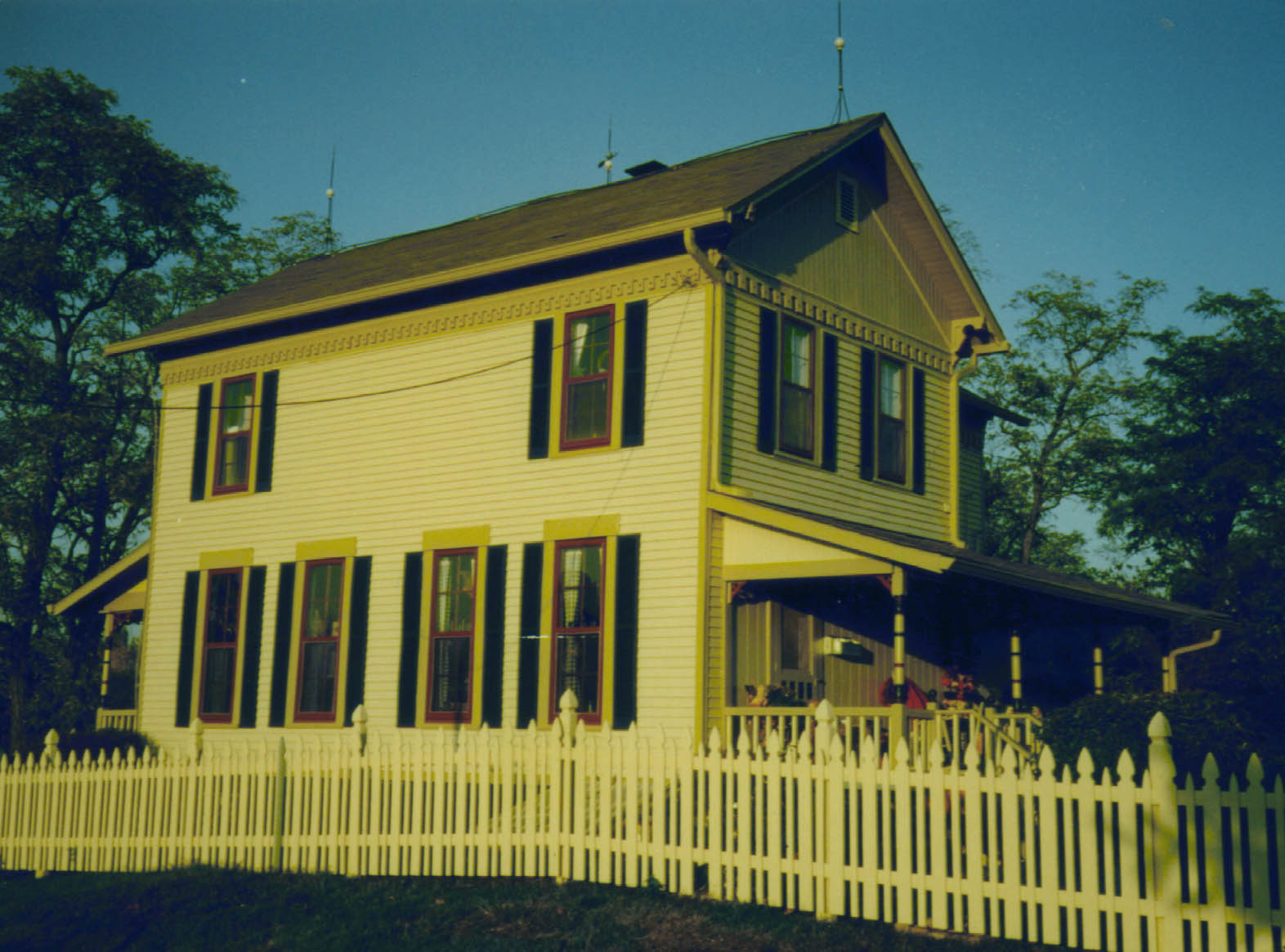 |
Along with the Gilmore and Adams families, John Markle, 1793-1865, was among the first settlers in 1823 to Adams Township. He laid out in 1854 the village that would become the township center and gave it his family name--Markleville. At the main intersection, he built the first cabin (see picture below) and lived there until his death. Mr. Markle was Markleville's first postmaster and a member of one of the first juries formed in the county. A friend and neighbor to author Samuel Harden, John Markle is remembered by that historian: "Strongly devoted to his friends, he hated his enemies as few men could hate." John Markle is buried in the McAllister Cemetery, which is northwest of Markleville.
While the McAllister
Cemetery does hold almost thirty Markle family members, there is within the
family history a st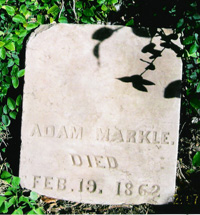 ory of a Markle family graveyard on what was once the D.C.
Markle property. On the 1876 plat map below, D.C. owned eighty acres in
the northwest quarter of section 21. According to family genealogists, the Markle plot was in the middle of the east boundary line, or near the "0" in the
"80" marking D.C. Markle's acreage.
While there is no record of this family graveyard, MCCC members have little
doubt that one did probably exist since many small family burial sites went
unrecorded and were eventually forgotten. The stone in the picture at
right rather proves the story. It was discovered in the 1960s in that
general location and given to a descendant. Adding to Harden's account, Adam and
Jacob Markle were brothers of John. They also moved into the township and
lived across from John on two other corners of Markleville's intersection.
Adam's wife was Mary Adams, and she died after her husband. She, like her
brother-in-law John, is buried in the McAllister. She has a large column
with her data on one side and Adam's data on the other. The family,
however, believes that Adam--as well as an unknown quantity of other Markles--was
interred at the family plot on D.C. Markle's property and that Adam is simply
memorialized on Mary's stone at the McAllister.
ory of a Markle family graveyard on what was once the D.C.
Markle property. On the 1876 plat map below, D.C. owned eighty acres in
the northwest quarter of section 21. According to family genealogists, the Markle plot was in the middle of the east boundary line, or near the "0" in the
"80" marking D.C. Markle's acreage.
While there is no record of this family graveyard, MCCC members have little
doubt that one did probably exist since many small family burial sites went
unrecorded and were eventually forgotten. The stone in the picture at
right rather proves the story. It was discovered in the 1960s in that
general location and given to a descendant. Adding to Harden's account, Adam and
Jacob Markle were brothers of John. They also moved into the township and
lived across from John on two other corners of Markleville's intersection.
Adam's wife was Mary Adams, and she died after her husband. She, like her
brother-in-law John, is buried in the McAllister. She has a large column
with her data on one side and Adam's data on the other. The family,
however, believes that Adam--as well as an unknown quantity of other Markles--was
interred at the family plot on D.C. Markle's property and that Adam is simply
memorialized on Mary's stone at the McAllister.
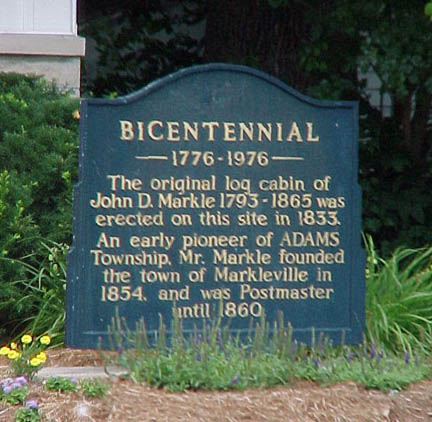 |
Markleville has remained a quaint village and is situated on the old Pendleton-Newcastle Pike (SR 38). An Indiana Historic Marker stands on the site of John Markle's log cabin on the northeast corner of Markleville's main intersection. The sign is decorated by and sits in front of the Madison Community Bank. |
Other pioneers who followed into the area in the 1820s were John, Joseph, and Moses Surber (see Busby Cemetery page); Abraham Blake; Anthony Hill; George Hodson with sons Isaiah, Eli, George, William, Jonathan, and David (see Capp-Tucker Cemetery page); Thornton Rector; Hugh and Morris Gilmore (see Gilmore Cemetery page); Thomas, William, and Garrett McAllister/McCallister (see McAllister Cemetery page); and Mr. Manly.
|
Built in 1856, the Andrew Bray house on CR 600S was the first two-story brick home in the southern part of the county. Historian Harden wrote that it was "simply palatial." Andrew Bray, a successful farmer and businessman, was for many years one of the wealthiest men in Madison County and for thirteen years was a justice of the peace for the township. (For more on Mr. Bray, go to the Capp-Tucker Cemetery.) Today, this home is being refurbished by private owners. |
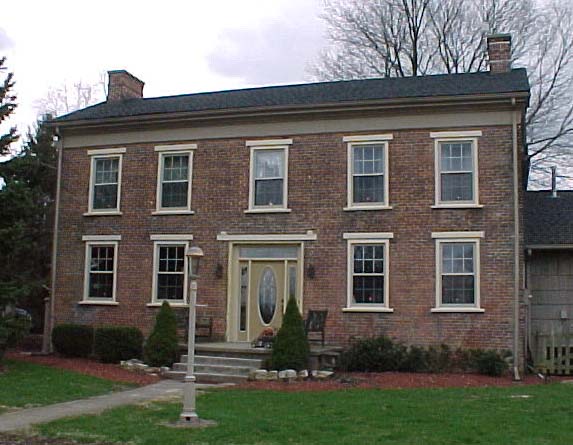 |
Eleven pioneer cemeteries are listed in modern records: Capp-Tucker, Collier, Evans, Kisling/Fleming/Old Keesling, Gilmore, McCallister/Walker, Ovid/Lutheran/Mt. Zion, Pee-Wee/Prince of Peace, Pendleton, Starr/Fesler (destroyed), and Williams (destroyed). Some of these are shown below on the Adams Township plat map from 1876.
Click here for modern map of township cemeteries.
